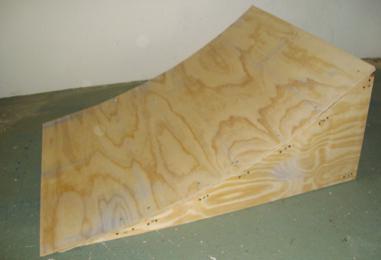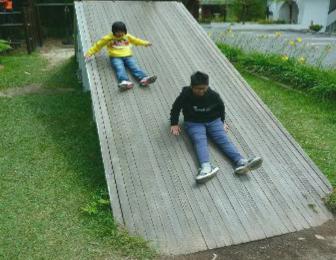Skip over navigation

Here are three little cars, each going on a journey.
For this activity, you will need three little cars. We are going to see how far they can travel.
You might use a small wooden ramp, like this:





Or search by topic
Number and algebra
Geometry and measure
Probability and statistics
Working mathematically
Advanced mathematics
For younger learners
Car Journey
Age 7 to 11
Challenge Level 





- Problem
- Getting Started
- Teachers' Resources
Car Journeys

Here are three little cars, each going on a journey.
For this activity, you will need three little cars. We are going to see how far they can travel.
You might use a small wooden ramp, like this:

Or you could make one using materials you have got.
You may like to use a big slide, like this one:
You may like to use a big slide, like this one:

If the ramp is wide enough, place all three cars at the top and LET GO!
Which went furthest? How do you know?
How far did each one travel from the bottom of the slope?
What could you try next?
Photograph Acknowledgement
www.skatebuilders.com
www.tripadvisor.com
Which went furthest? How do you know?
How far did each one travel from the bottom of the slope?
What could you try next?
Photograph Acknowledgement
www.skatebuilders.com
www.tripadvisor.com
Why do this problem?
This problem is a playful activity that gives pupils the opportunity to explore different ways of measuring length/distance. It could lead into considerations of standard and non-standard units of measure, and will certainly involve children comparing lengths/distances.Possible approach
You may need to consider whether this is for the whole class or a group at a time.Make sure that there is a suitable slope to use and there are small cars available, and allow the children to explore as you stand back. You may need to encourage some sort of measurement but try not to impose particular ways of measuring, rather let learners try out their own.
After a suitable length of time, you could draw the whole group together to share the different ways they measured. If appropriate, you could begin to discuss which way/s might be most helpful and why.
After a suitable length of time, you could draw the whole group together to share the different ways they measured. If appropriate, you could begin to discuss which way/s might be most helpful and why.
Key questions
Which car went the furthest?
How far did that car go?
How do you know?
How much further did that car go than the next car?
How far did that car go?
How do you know?
How much further did that car go than the next car?
Possible extension
Some children could be encouraged to find ways of recording the distances for the three cars and then for every car that the group/class used. Talk about what they can find out from their recordings.Possible support
Some children may need some support if their fine motor skills prevent them from holding the car at the top of the slope and carefully letting go. This may also apply to the use of any measuring equipment that may be used.You may also like
Great Squares
Investigate how this pattern of squares continues. You could measure lengths, areas and angles.
Watch the Clock
During the third hour after midnight the hands on a clock point in the same direction (so one hand is over the top of the other). At what time, to the nearest second, does this happen?
Walk and Ride
How far have these students walked by the time the teacher's car reaches them after their bus broke down?

